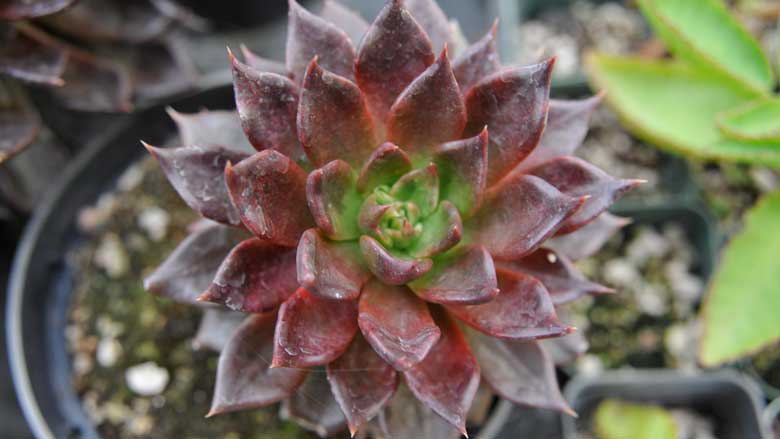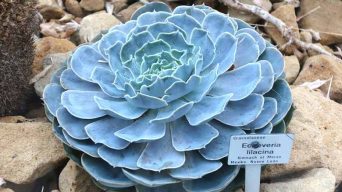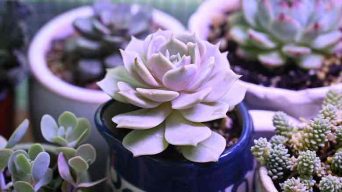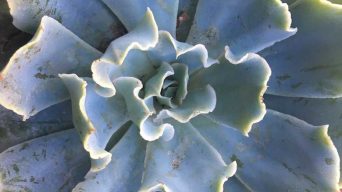The Echeveria ‘Black Prince’ is a beautiful type of succulent that has striking leaves.
The leaves are very dark, almost black or purple, making them stand out from other types of Echeveria that have lighter-colored leaves.
The Echeveria ‘Black Prince’ is one the most popular types of Echeveria due to its very striking and different appearance.
However, not only do the leaves look great – this plant has a lot more benefits than just looking amazing.
Growing Echeveria ‘Black Prince’ is not too difficult if you follow the right growing conditions.
This article will deal with all aspects of taking care and propagating the Echeveria ‘Black Prince’.
Overview
The Echeveria genus consists of a wide range of flowering plants endemic to Mexico’s desert regions.
One of the more popular species in the Echeveria genus is the Echeveria ‘Black Prince’.
This slow-growing succulent is a cross between Echeveria affinis and Echeveria shaviana.
Echeveria ‘Black Prince’ is a succulent with dark triangle-shaped leaves that clump together.
The short rosettes are up to 3 inches (7.5 cm) in diameter, and the leaves take on a dark brownish-purple tint as they mature.
The lower leaves gradually broaden from the base to 1 inch (2.5 cm) in width and have a fine, yellow margin with age.
In the fall and winter, the Black Prince Echeveria produces short stocks topped with colorful clusters of dark red flowers.
The dark red flowers appear on short stalks in late fall to early winter.
How To Care for Echeveria ‘Black Prince’
The best thing about the Echeveria ‘Black Prince’ is that it is extremely easy to take care of.
However, there are a few factors to keep in mind when caring for this succulent plant and a few things you should avoid doing.
Below you’ll find the essential information you need to know about caring for Echeveria ‘Black Prince’.
Sun Exposure & Light Requirements
Echeveria ‘Black Prince’ is a succulent that generally can survive in full sun and partial shade, but the color will be affected.
For example: in intense light, it gets more grey tones, and when grown under dry conditions – where there is less water – the leaves get more intense to purple tones.
Echeveria ‘Black Prince’ is a low-growing succulent plant that can adapt to most locations.
However, it is always better for this kind of plant to place in regions where they are exposed to full sun during the morning hours – with some afternoon shade.
When grown indoors, make sure you place the pot near a window where they will get plenty of bright, indirect light or even put them under full sun.
However, make sure to avoid intense direct sunlight during the hottest hours of the day since it could burn the leaves and even cause damage to the plant.
Watering Requirements
Watering for this Echeveria is relatively simple. You should water it when the soil is dry to the touch.
Make sure to use the ‘finger test’ (stick your finger into the soil, if it is dry up to your first knuckle, it’s time to water). When you water, do so thoroughly.
Ensure there is enough drainage for excess water to flow out of the pot.
You should never leave this plant sitting in a small pool of water (it can cause root rot and fungal infections).
Don’t let this plant sit in stagnant water as well, its roots will rot.
Also, it’s important to water directly into the soil. If you water on top of these plants, it can cause the leaves to become wet and susceptible to rot.
Soil Requirements
Echeveria ‘Black Prince’ is an easy plant to take care of and requires well-draining soil.
A cactus potting mix would be perfect for this succulent, but it can also be grown in standard soil with extra coarse sand and perlite mixed in.
This will help the plant to drain properly because regular soil tends to become soggy and heavy.
Echeveria ‘Black Prince’ is a pretty tolerant plant when it comes to soil conditions because it can grow in a wide range of soils with different compositions, but one thing that must stay constant is the drainage properties of the soil.
Temperature and Humidity
Echeveria ‘Black Prince’ succulents like to be in warm conditions which are neither too hot nor too cold.
They like to be kept around 15°C (59°F) and should usually not go below 20°F (6.7°C) during the night. However, they can tolerate temperatures down to 10°F (-12.2°C) for short periods.
If the temperature goes below these points, you might want to protect your plant by moving it somewhere warmer or heated.
Echeveria ‘Black Prince’ plants are also used to dry conditions, so they don’t need much humidity. You should not mist your succulents because they are likely to get rot.
Fertilizing
Echeveria ‘Black Prince’, like the rest of succulent plants, thrives in nutrient-poor soil.
They can’t absorb nutrients through their roots as fast as regular plant types, which is why they are preferred to be fertilized less often than others.
Their soil should be as nutrient-free as possible, and they will only need to be fertilized when they are actively growing.
Growing Echeveria ‘Black Prince’ indoors is an excellent way to allow them to flourish without needing much fertilizer.
As for fertilizing during the growing season, it’s best not to use concentrated fertilizers because their strong chemical makeup may damage or kill your plant.
It’s recommended that you mix 1/8 teaspoon of a balanced plant fertilizer into 1 gallon of water, then use this mixture once a month.
Potting and Repotting
Echeveria ‘Black Prince’ is a slow grower, so there is little need to repot, but it can be done if you feel like giving your Echeveria a bigger pot.
When repotting, never do it when the weather is cold, but it can be done during spring or summertime.
And before repotting, make sure that you clean the previous pot properly and use terracotta or unglazed pots with drainage holes to provide better air circulation for your Echeveria.
To repot your Echeverias, place the plant into its new pot, fill in around it with fresh soil, then pack down lightly with your fingers or a blunt tool so no air pockets remain.
Be careful not to damage or break its roots when transplanting it and giving your Echeveria a nice fresh soil mixture.
Don’t water it for at least a week or two, then once you do water your Echeveria, do it thoroughly so the soil is fully moist.
Pruning
After flowering, it is recommended to prune the Echeveria ‘Black Prince’.
By removing flowers, old leaves, and excess plant material, the number of pests like mealybugs will be reduced.
This also helps the new plant leaves to have enough nutrients.
In addition, it is a very good idea to cut off some of the stems of this Echeveria because that will enable fresh new growth near the base of the plant.
Pruning may promote better airflow and sunlight penetration into the plant.
To prune, simply cut away any dead or damaged leaves or stems of the Echeveria ‘Black Prince’.
You can leave the healthy parts to grow by cutting the stem into two at a diagonal angle with some leaves on it.
Pests and Diseases
Echeveria ‘Black Prince’ is typically pest and disease resistant, but there are still some pests that can cause havoc to your succulent plant.
The most common pest for this succulent plant is aphids, which feed on the sap of the succulents. These can be easily removed by wiping with a cotton swab.
Another pest is the mealybug, which can be killed by water and rubbing alcohol. You can add some drops of dish soap to your mixture for extra killing power.
As for diseases, this type of succulent is usually pretty disease resistant, but you can still encounter problems like fungal infections and rot.
If your plant starts to rot, the best thing to do is to cut off the infected parts and discard them. Make sure you clean your knife after the procedure!
Finally, remember that excessive watering of your succulents can increase their vulnerability to diseases. Therefore, ensure that you only water them when the soil has dried out.
How to Care for Echeveria ‘Black Prince’ in Winter
Echeveria ‘Black Prince’ is a rosette succulent so that it can survive temperatures around 20°F (6.7°C) in the plant’s natural growing season.
So if your winter weather conditions are mild with no freeze, you can grow these plants outdoors throughout the year.
But people living in freeze zones have to overwinter these plants indoors by bringing the succulents indoors before the frost because the freeze will kill these plants.
When your plants come indoors, and you’re all set up for overwintering succulents, put them in a bright area of the house.
They will still need some light to grow, but not as much light as they would receive outside or if you leave them in a sunny window (bright indirect light).
If your house is primarily dark, try using grow lights.
Water these succulents very sparingly when the temperature falls below 50°F (10°C).
You don’t need to fertilize them during winter because there’s not enough light for them to grow well.
Although the plant will go dormant during winter, it can still be watered once a month to keep its roots from drying out.
In springtime, when the indoor temperatures have warmed up, and you’re ready to bring your succulents back outside, you can slowly acclimate them to full sun first by gradually moving them where they’ll receive at least 6 hours a day of bright sun.
If you don’t plan to relocate your plants outside in springtime, start watering them when the temperatures have warmed up enough for you to do so.
In milder climates where the freeze isn’t too extreme, these succulents can be taken out from overwintering after the danger of frost has passed.
How To Propagate Echeveria ‘Black Prince’
Echeveria Black Prince propagates easily by leaves or offsets.
How To Propagate By Leaf Cuttings
To propagate Echeveria Black Prince by leaf cuttings, remove a healthy and mature leaf from the stem.
It is important to ensure that the base of the leaf has not been damaged. Ensure that there is not any rot on either end of the leaf.
Allow this leaf cutting to callous over in an area that is well-lit but not in direct sunlight.
Once the cutting has been calloused over, lay the cutting in some well-draining soil and be sure that the soil is kept moist.
Once rooted, regularly plant this new succulent in a pot with well-draining soil and water.
How To Propagate Through Offsets
Echeveria ‘Black Prince’ propagates easily through offsets.
Offsets are the small plantlets that have developed off a parent plant’s base.
To propagate Echeveria ‘Black Prince’ through offsets, gently pull the new offset from the mother plant and place it in soil with some well-draining soil.
Water regularly until rooted.
Plant this new succulent in its own pot once rooted.
Final Thoughts
Growing succulents is a gratifying activity, and propagating them is an excellent way to expand your collection and share the fun with friends or family members.
The Echeveria ‘Black Prince’ is a good place for beginner succulent gardeners to begin as it’s relatively resilient, easy to care for, not to mention stunningly beautiful.







